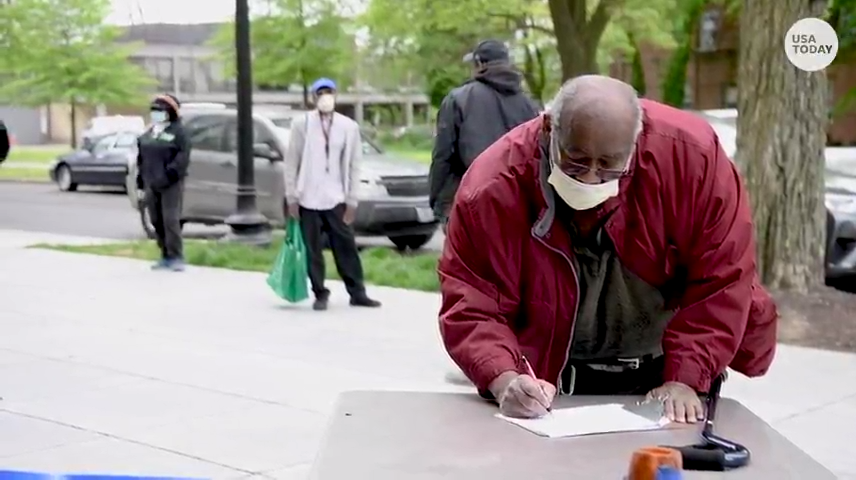COVID-19 has left millions of Americans without enough food. Here's how Senate can help.
As a nation, we have a moral and economic obligation to address child hunger, food insecurity and avoid economic collapse in the wake of COVID-19. While we have different political viewpoints, we strongly agree that the Supplemental Nutrition Assistance Program is one of the most effective tools we have to fight the looming health and economic crises facing our great country.
The Senate is at a critical decision point as to how we use this tool. That’s why together, we are calling for a temporary 15 percent increase in SNAP benefits, bound to economic indicators, in the next federal coronavirus relief package.
Even in the best of economic times, far too many Americans struggle to put food on the table. This is especially concerning for families, where children need nutritious food to grow up healthy and strong.
Today’s environment is unlike anything our nation has ever experienced. We are on the brink of an economic and food security disaster that will impact every citizen, but disproportionately affect vulnerable individuals including children, the elderly, rural Americans, Black, indigenous and people of color.

For years, the number of hungry children was declining. But, a new Save the Children report shows that many children now face even greater risk. New estimates from Northwestern University based on Census Bureau data indicate the percentage of families who are considered food insecure has increased during the pandemic, is much higher than during the Great Recession, and, of great concern, disproportionately affect children and families of color.
Rural communities hit hard
The situation is particularly stark in rural communities. Even before the pandemic, Feeding America data showed that nearly 90 percent of the counties with the highest percentage of children at risk of going hungry were rural. Kentucky, Alabama, Arkansas, Mississippi, Texas, Louisiana, New Mexico, Oklahoma, Nevada and North Carolina will be hit hardest by growing food insecurity in the wake of the pandemic, according to new projections.
Children such as Emma and Devan from rural Kentucky relied on meals served at school. Their great-great-grandmother Claudette, who is raising the kids, didn’t realize how much milk and bread her children go through in a week. She doesn’t have reliable transportation to get to the grocery store about 30 miles away, and because of her age, she falls into a higher-risk category should she contract COVID-19.
Since the closures, their family has benefited from food distributions and meal deliveries by school bus. Stress, in addition to hunger, is certainly rising in rural pockets across America, with schools going into the red to fill the feeding gap.
During normal times, America could turn to stopgaps like food banks and other feeding initiatives to supplement federal nutrition programs. Despite additional support in the CARES Act, the unprecedented need stemming from this pandemic has already strained existing resources and programs, with no end in sight.
Charities can't keep up with needs
Save the Children has helped serve rural children more than 1.8 million meals from the end of March through May. Yet, reports of staggering, miles-long lines at food pantries show that we simply cannot expect hunger relief organizations or schools to meet the need alone.
We do not know how long the economic damage of the pandemic will last. SNAP can and should be part of the solution — putting resources directly and immediately into the wallets of Americans. A temporary 15 percent increase in the SNAP maximum allotment level would equate to an additional $25 per person per month.
Every dollar in SNAP benefits generates about $1.54 in economic activity. Increased spending on food enabled by SNAP supports essential businesses small and large, stimulates local economies and helps to support American farmers.
Of note, SNAP infrastructure already exists and stands ready to immediately distribute benefits directly to those who are eligible. Working within an existing program avoids the high costs and long delays associated with standing up a new program.
SNAP’s strict eligibility requirements prevent benefits from going to those who are not truly in need and ensure that no one who needs and wants the help is inadvertently left out.
Preventing children from going hungry, implementing smart, efficient policy solutions and supporting economic security for millions of Americans are common ground issues, no matter your political party. We come from different backgrounds, have different political beliefs and have different views on a host of policy issues, but on this, we are aligned and in lock step, because we know it’ll help kids like Emma and Devan.
Temporarily boosting SNAP by 15 percent is one tool that’s readily available to immediately keep American children from going hungry and shield them from the worst economic impacts of COVID-19. We urge Sen. Mitch McConnell, Sen. Chuck Schumer and their fellow senators to use it.
Dr. Bill Frist is a heart transplant surgeon, former U.S. Senate Majority Leader and a senior fellow at the Bipartisan Policy Center. He co-chaired the policy center's SNAP Task Force, which published “Leading with Nutrition: Leveraging Federal Programs for Better Health.”
Mark K. Shriver is senior vice president of U.S. Programs and Advocacy at Save the Children. In June, Save the Children released "The Land of Inopportunity: Closing the Childhood Equity Gap for America’s Kids," which features county-level rankings for child well-being, including food insecurity.
You can read diverse opinions from our Board of Contributors and other writers on the Opinion front page, on Twitter @usatodayopinion and in our daily Opinion newsletter. To respond to a column, submit a comment to letters@usatoday.com.
This article originally appeared on USA TODAY: COVID-19 has led to surge in child hunger. Here's how we can help.

